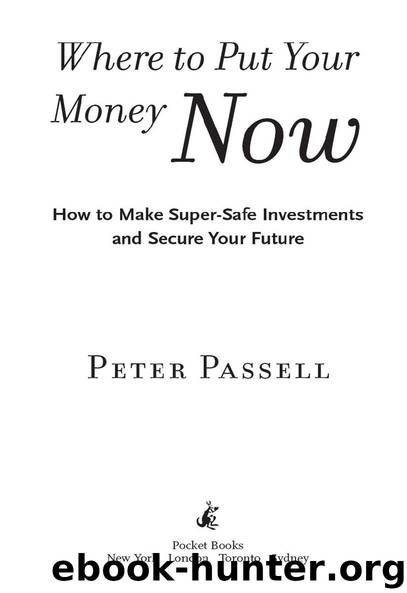Where to Put Your Money Now by Peter Passell

Author:Peter Passell
Language: eng
Format: epub
Publisher: Simon and Schuster
Published: 2009-07-15T00:00:00+00:00
There is no substitute for comparison shopping, but four companies are a good place to start because they have both strong financial ratings and reputations for treating consumers fairly:
TIAA-CREF
The primary business of this gigantic organization is to manage pensions (annuities) for college teachers. But it will sell annuities to anybody. Visit tiaa-cref.org.
Vanguard
The gold standard among full-service investment firms, known for low-fee financial products. The company sells immediate annuities through the Vanguard Lifetime Income Program. Visit vanguard.com or call the annuity line at 1-800-523-0352.
Fidelity
The chief competitor to Vanguard in the low-cost, full-service investment business. Visit fidelity.com or call 1-800-345-1388.
USAA
This company provides excellent financial services at good prices—but only to military personnel (active or retired) and their families (including grown children). Visit usaa.com or call 1-800-531-8722.
REVERSE MORTGAGES
Mortgages are loans, not investments. Why are they included here? Reverse mortgages, like other mortgages, are loans against the equity in your house. But they have a place in discussions of safe investment strategies because they offer a way to generate a steady stream of cash in retirement without putting the owner of the house at risk of foreclosure. A reverse mortgage is hardly the right investment for every retired person with some equity in a house. Indeed, the costs of this financial product are so high that it should be seen as a last resort for healthy elderly who want to stay in their homes, but need more income to manage it.
With a regular mortgage, you borrow money using the house as collateral, which guarantees that the lender won’t lose money if you stop making payments.* * With a reverse mortgage, you also borrow against the value of the house. But the loan is structured so you never have to pay back a penny until you leave the house.
That seems like a good idea for people who need income more than they need to leave a house to their heirs. But there are multiple problems. First, the closing costs on reverse mortgages are exceptionally high—often more than $10,000 on what amounts to a loan of less than $200,000. Second, many elderly eventually need assisted living; when they leave the house, the reverse mortgage comes due and they end up with less (or nothing) when the house is sold to pay off the loan. Third, the terms of reverse mortgages can be difficult to understand, especially for the very old people who really need them. Not surprisingly, then, it has been a business rife with scams.
Oh, did I forget to mention the fourth reason that reverse mortgages are problematic? The amount of equity in the typical house has fallen sharply since 2006, reducing the sums available to borrow.
If you (or an elderly relative) are prepared to venture into the reverse-mortgage thicket:
Stick with lenders offering mortgages under the federal government’s Home Equity Conversion Mortgage program. These federally insured mortgages limit fees and proscribe unfair terms.
Use the reverse mortgage calculator available free online from the National Reverse Mortgage Lenders Association. It spells out the costs of a standard reverse mortgage tailored to your needs and estimates how much cash you could get monthly.
Download
This site does not store any files on its server. We only index and link to content provided by other sites. Please contact the content providers to delete copyright contents if any and email us, we'll remove relevant links or contents immediately.
The Black Swan by Nassim Nicholas Taleb(6762)
Bad Blood by John Carreyrou(6274)
Pioneering Portfolio Management by David F. Swensen(6078)
Millionaire: The Philanderer, Gambler, and Duelist Who Invented Modern Finance by Janet Gleeson(4092)
Skin in the Game by Nassim Nicholas Taleb(3965)
The Money Culture by Michael Lewis(3846)
Bullshit Jobs by David Graeber(3826)
Skin in the Game: Hidden Asymmetries in Daily Life by Nassim Nicholas Taleb(3720)
The Wisdom of Finance by Mihir Desai(3523)
Blockchain Basics by Daniel Drescher(3327)
Liar's Poker by Michael Lewis(3220)
The Intelligent Investor by Benjamin Graham Jason Zweig(2930)
Hands-On Machine Learning for Algorithmic Trading by Stefan Jansen(2925)
Mastering Bitcoin: Programming the Open Blockchain by Andreas M. Antonopoulos(2891)
Fooled by Randomness: The Hidden Role of Chance in Life and in the Markets by Nassim Nicholas Taleb(2860)
Investing For Dummies by Eric Tyson(2791)
The Power of Broke by Daymond John(2770)
Market Wizards by Jack D. Schwager(2538)
Zero Hour by Harry S. Dent Jr. & Andrew Pancholi(2531)
